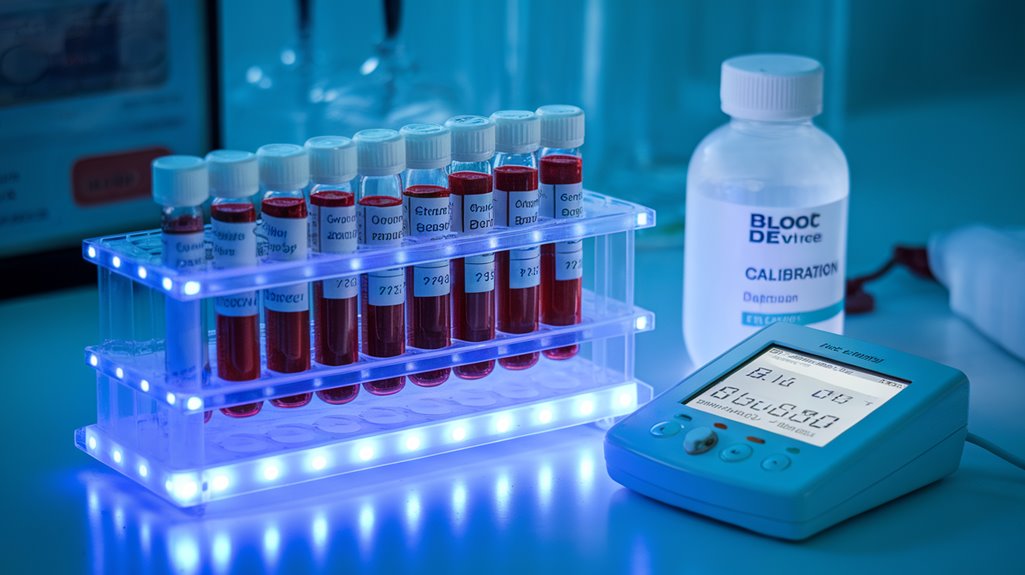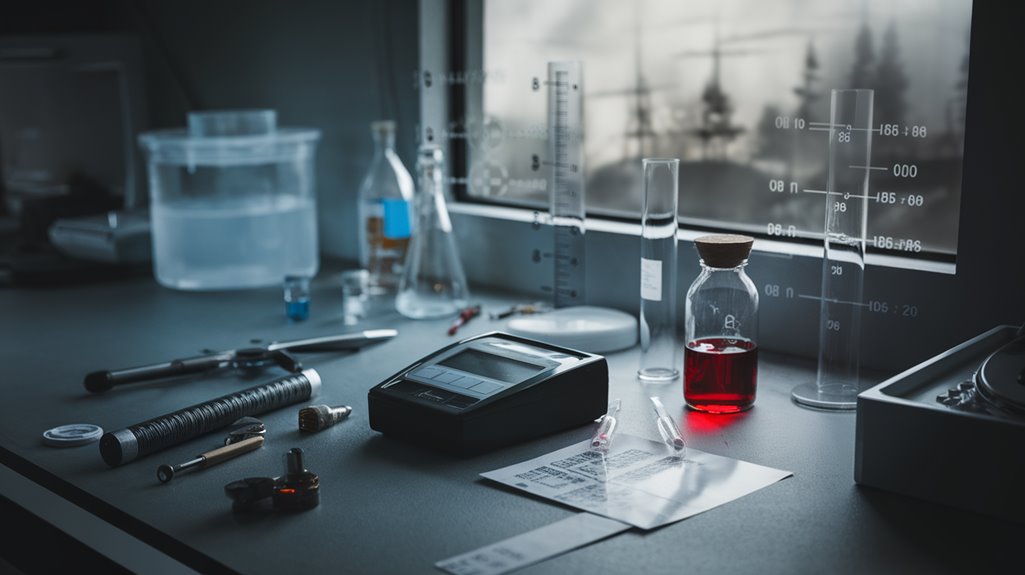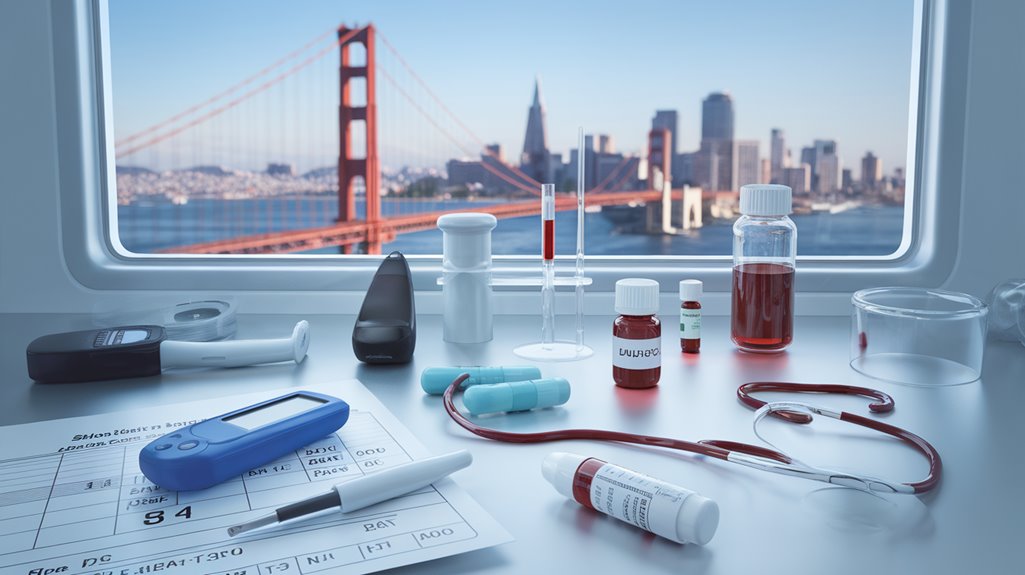A BAC reading of 0.08 or higher doesn't automatically mean guilt in Bay Area DUI cases. Multiple factors can challenge test accuracy, including medical conditions, improper equipment maintenance, and environmental influences. Breathalyzers require regular calibration and can be affected by acid reflux, diabetes, or certain diets. Legal defenses can question testing procedures, timing, and officer protocols. Valid explanations exist for seemingly high BAC levels, and understanding these factors creates stronger defense options.
Key Takeaways
- Medical conditions like diabetes, GERD, or acid reflux can create false high BAC readings that may invalidate test results.
- Improper calibration, maintenance issues, or officer errors in breathalyzer operation can make BAC evidence inadmissible in court.
- The "rising BAC" defense can prove blood alcohol was below 0.08 while driving, despite higher test results later.
- Environmental factors and industrial contaminants in the Bay Area can interfere with breathalyzer accuracy.
- Time gaps between traffic stop and testing, combined with expert testimony, can challenge the validity of BAC readings.
The Science Behind Blood Alcohol Content Testing

When alcohol enters the body, it quickly moves from the stomach and small intestines into the bloodstream, typically within 30 minutes of consumption. BAC measurement techniques include blood tests, breathalyzers, and urine analysis, each with distinct advantages and limitations.
Blood tests provide the most accurate results through laboratory analysis using gas chromatography or enzymatic methods. These tests require trained professionals to draw blood and proper preservation with sodium fluoride. Breathalyzers offer immediate results by detecting breath ethanol but may be less precise than blood tests. Test result variability can occur due to several factors, including individual metabolism rates, gender differences, and testing conditions.
The human body processes alcohol at approximately 0.015-0.025% BAC per hour, with women generally metabolizing alcohol more slowly than men due to lower enzyme production.
Common Factors That Can Affect BAC Test Accuracy
Various medical conditions like diabetes and acid reflux can greatly alter breathalyzer readings and lead to inaccurate BAC results. Breathalyzer devices require regular calibration and maintenance to deliver reliable measurements, with improper upkeep often causing false readings. The way testing devices are stored and transported, especially in extreme temperatures or near chemical substances, can compromise their accuracy and dependability.
Medical Conditions Impact Testing
Medical conditions play a significant role in affecting Blood Alcohol Content (BAC) test results. Various health issues can lead to medical misinterpretations and metabolic influences that cause false readings on breath testing devices.
- Gastrointestinal disorders like GERD and acid reflux release substances that breath tests can mistake for alcohol
- Respiratory conditions, including asthma and COPD, prevent proper breath sampling through shallow or inconsistent breathing patterns
- Metabolic disorders such as diabetes produce acetone that testing devices confuse with alcohol
- Neurological factors like hyperventilation from test anxiety can alter ethanol exhalation rates
These medical conditions create legitimate concerns about BAC test accuracy, as they can produce false positives or skewed results that don't reflect actual alcohol consumption levels.
Device Calibration Issues
Breath testing devices require precise calibration to deliver accurate BAC readings. Regular servicing and certification are mandatory under FDLE standards to maintain device reliability. When calibration discrepancies occur, BAC readings can be inflated by 15-20% above actual levels, potentially leading to false results.
Testing devices face multiple accuracy challenges. Research shows that up to 23% of breath tests report BAC levels 0.02% higher than corresponding blood samples due to systemic errors. A notable example occurred in 2010 when Intoxilyzer devices in D.C. miscalculated BACs by 20%, affecting approximately 400 convictions. For test results to be admissible in court, proper maintenance records and calibration certificates must be available. Additionally, officers must be certified to operate these devices, as improper training can invalidate test results.
Storage and Transport Problems
Physical conditions during storage and transport of breath testing devices can greatly impact BAC measurement accuracy. When devices experience poor storage conditions or transport errors, their internal components can become compromised, leading to unreliable test results.
- Rapid temperature changes during transport can warp plastic components, affecting the vital air-to-breath ratios needed for accurate readings
- High humidity in storage locations interferes with proper sample ionization, potentially inflating BAC levels
- Storage issues near cleaning products or organic solvents like chlorine can contaminate sensors and alter device readings
- Transport errors exposing devices to paint or gasoline fumes may cause device malfunctions and compromise test accuracy
These storage and transport problems underscore why BAC readings should be carefully scrutinized, as environmental factors can markedly affect testing equipment reliability.
Legal Requirements for DUI Traffic Stops in California
California law requires police officers to establish probable cause before initiating a DUI traffic stop, which can stem from observed traffic violations or erratic driving patterns. DUI checkpoints must follow strict guidelines established by the Ingersoll case to guarantee fair and consistent treatment of all drivers. Officers conducting these stops need to document specific observations that led to their reasonable suspicion, as defendants can challenge stops lacking proper cause through suppression motions.
Probable Cause Standards
When law enforcement officers conduct DUI traffic stops in California, they must follow strict probable cause standards. These standards require specific, observable facts rather than mere hunches or unreliable tips. Officers need to document clear probable cause examples that show reasonable suspicion of impaired driving.
- Observable driving behaviors like weaving, erratic lane changes, or running red lights
- Physical signs of intoxication such as slurred speech, bloodshot eyes, or alcohol odor
- Poor performance on field sobriety tests indicating impairment
- Objective evidence that can be verified in court, not just officer opinions
California courts emphasize that probable cause must be based on contemporaneous observations, not after-the-fact justifications. This higher standard protects drivers from arbitrary stops while allowing officers to maintain public safety through proper DUI enforcement.
Checkpoint Legal Requirements
Legal operation of DUI checkpoints in California requires strict adherence to multiple constitutional safeguards. Checkpoint procedures must include advance public notice and clear signage indicating the checkpoint's presence and purpose. Officers cannot arbitrarily select which vehicles to stop but must follow predetermined numerical sequences.
The legal implications of improper checkpoint operations can invalidate arrests. Police must maintain detailed logs documenting all stops, and agencies must report checkpoint data to the California Office of Traffic Safety. Stops are limited to brief durations unless officers develop probable cause for further investigation. Additionally, field sobriety tests require voluntary consent in non-arrest situations, and officers cannot extend detentions without proper justification. Any deviation from these requirements may result in evidence being excluded from court proceedings.
Challenging the Validity of Breath and Blood Tests

Despite rigorous testing protocols, both breath and blood tests used to measure blood alcohol concentration (BAC) can be challenged on multiple grounds. Questions about breathalyzer accuracy and blood test reliability often arise from maintenance issues, operator errors, and environmental factors.
- Device calibration problems, including missed recalibration intervals and outdated standards, can render test results inadmissible
- Officer errors, such as failing to observe proper waiting periods or improper handling of equipment, may invalidate readings
- Medical conditions like GERD or recent use of certain products containing alcohol can lead to falsely elevated BAC readings
- Blood samples face their own challenges, including chain of custody issues, improper storage conditions, and chemical interactions with preservatives or medications
These vulnerabilities create opportunities to contest BAC evidence in court.
The Role of Field Sobriety Tests Beyond BAC Numbers
Field sobriety tests serve purposes that extend far beyond simply estimating blood alcohol levels. These tests help officers observe a person's physical coordination, mental alertness, and ability to follow instructions – factors that indicate overall impairment regardless of BAC readings.
Test performance variability plays a significant role in field sobriety implications. Medical conditions like vertigo, environmental factors such as uneven pavement, and even normal stress from being stopped can affect results. Officers must consider these variables when evaluating a person's sobriety.
The tests also provide documentation of behavior that may be relevant in court. While studies show correlation between test performance and BAC levels, the relationship isn't perfect. Officers use these observations alongside chemical test results to build a more complete picture of impairment.
How Medical Conditions Impact BAC Test Results

Medical conditions play a surprisingly significant role in blood alcohol testing accuracy. Several common health issues can trigger false BAC readings, leading to significant legal implications for drivers who haven't consumed alcohol.
- Acid reflux and GERD create ethanol molecules in the throat, causing breathalyzers to detect mouth alcohol instead of actual consumption
- Diabetic ketoacidosis produces isopropyl alcohol that breathalyzers mistake for ethanol
- High-protein and ketogenic diets increase gut fermentation, releasing alcohol-like compounds
- Respiratory conditions and asthma medications contain alcohol-based ingredients that can contaminate breath samples
These medical explanations often provide valid defenses in DUI cases, as they demonstrate how BAC readings can be unreliable due to underlying health conditions rather than alcohol consumption.
Building a Strong Defense Despite High BAC Readings
While high BAC readings often seem like insurmountable evidence in DUI cases, defendants can build strong legal defenses by focusing on specific technical and procedural elements.
One of the most effective defense strategies involves the Rising BAC defense, which applies when test results fall between 0.08% and 0.11%. This approach argues that while the test showed an illegal level, the actual BAC was lower when driving occurred. Time gaps between driving and testing strengthen this defense, especially when supported by toxicologist testimony.
Additional defense strategies include challenging the validity of BAC tests themselves. Issues like improper machine calibration, officer errors during testing procedures, or failure to observe mandatory waiting periods can cast doubt on results. Women's faster alcohol metabolism rates and environmental factors like industrial contaminants can also impact test accuracy.
Alternative Charges and Plea Bargaining Options

Defendants facing DUI charges with high BAC readings may have options beyond accepting the original charges. Through plea negotiation strategies and alternative sentencing options, qualified cases can pursue different resolutions, especially for first-time offenders or those willing to participate in rehabilitation programs.
- DUI court programs are available in counties like San Mateo and Marin for repeat offenders, offering structured rehabilitation instead of traditional penalties
- Prosecutors may reduce charges to "wet reckless" or other lesser offenses when circumstances warrant
- Deferred prosecution agreements allow first-time offenders to complete community service or rehabilitation to avoid conviction
- MADD Victim Impact Panel attendance can be incorporated into plea deals, demonstrating commitment to understanding consequences
These alternatives often require early intervention and proper legal representation to negotiate favorable terms with prosecutors.
Technical Equipment Maintenance and Testing Protocols
Maintaining accurate breath testing equipment requires strict adherence to quality assurance protocols. Testing protocols dictate specific maintenance schedules and calibration requirements for different devices. The DataMaster needs annual QA testing, while Alco-Sensor III PBTs require certification every six months.
| Device Type | Calibration Frequency | Required Testing |
|---|---|---|
| Stationary Units | 120-150 tests | Annual QA |
| Mobile Units | 50-75 tests | 6-month checks |
| Simulators | When ±0.2°C deviation | Pre/post repair |
Instruments must stay within ±10% tolerance for screening applications. Any repairs involving temperature adjustments beyond 34°C ±0.2°C trigger mandatory recalibration. Maintenance schedules include documentation of all repairs, calibrations, and accuracy checks. Equipment failing tolerance limits remains out of service until proper recalibration restores accuracy standards.
Frequently Asked Questions
Can I Refuse a Breathalyzer Test in California Without Legal Consequences?
No, refusing a breathalyzer test in California carries significant legal consequences. The refusal automatically triggers a one-year license suspension for first-time offenders, even if the DUI charge is dismissed. Legal rights are impacted as refusal can lead to enhanced criminal penalties, mandatory DUI programs, and ineligibility for restricted licenses. Additionally, prosecutors can use the refusal as evidence of guilt in court, making legal defense more challenging.
How Soon After Drinking Can I Legally Drive?
Like a ticking clock that can't be rushed, alcohol needs time to clear from the body. Driving laws recommend waiting at least one hour per standard drink consumed. However, alcohol absorption varies greatly between individuals based on weight, gender, food intake, and age. The safest approach is waiting several hours after drinking, as even small amounts can impair driving ability. There's no magic formula – when in doubt, wait it out or find alternative transportation.
Do Different Alcoholic Beverages Affect BAC Readings Differently?
Different alcoholic beverages can affect BAC readings in varying ways. Beer vs. wine comparisons show that higher alcohol content drinks like wine (12% ABV) raise BAC faster than beer (5% ABV). Spirits impact BAC even more dramatically due to their higher concentration (40% ABV). Carbonation in beer can speed up alcohol absorption, while mixers in cocktails may slow it down. The serving size and alcohol percentage matter more than the type of drink itself.
Will Eating Food While Drinking Help Lower My BAC Level?
Picture a sponge slowly soaking up water – that's how alcohol enters the bloodstream. Food acts like a barrier, especially proteins and carbs, slowing down alcohol absorption into the body. While eating won't reduce the total amount of alcohol consumed, it can help lower peak BAC levels by creating a slower, steadier drinking pace. The food basically creates a dam in the stomach, controlling how quickly alcohol flows into the system.
How Accurate Are Personal Breathalyzer Devices Sold in Stores?
Store bought personal breathalyzer devices vary considerably in accuracy. While some models like the BACtrack C6 can be accurate within 0.1% of police equipment, many others show inconsistent results. These devices can be affected by multiple factors including temperature, altitude, and user technique. Environmental conditions and physiological differences between users also impact readings. For most reliable results, users should choose quality brands and follow proper testing protocols.
Conclusion
BAC readings above 0. 08 don’t always lead to DUI convictions in the Bay Area. Take the 2019 Castro Valley case, where a defendant’s 0. 10 reading was thrown out due to improper breathalyzer calibration. Things like medical conditions, testing errors, and procedure mistakes can affect results. A good defense lawyer looks at all these factors. The number is just one piece of evidence, not the whole story. In fact, some cases with high BAC readings have been dismissed due to insufficient evidence beyond the test result. Experienced attorneys scrutinize every detail, from officer conduct to potential violations of constitutional rights, to challenge the prosecution’s case. Unlike federal convictions in the Bay Area, where sentencing can be stricter, DUI cases often hinge on state laws and specific legal defenses. Moreover, the successful navigation of DUI cases often requires a comprehensive understanding of the nuances of the law, including understanding disorderly conduct violations that may complicate a case. These violations can sometimes be used as leverage in negotiations or play a significant role in a defendant’s overall strategy. Ultimately, having a strong legal advocate can make a considerable difference in the outcome, ensuring that all aspects are examined and that the defendant’s rights are vigorously defended. Additionally, it’s important to recognize that plea agreements in the Bay Area can sometimes offer more lenient alternatives to full convictions, allowing defendants to avoid harsher penalties while still addressing their charges. Defense attorneys often negotiate these agreements based on the strength of the evidence and the specifics of the case, which can include not only BAC results but also mitigating factors. Ultimately, the combination of skilled legal representation and a thorough examination of all case details can lead to favorable outcomes even in situations where the initial BAC reading appears incriminating. In addition to scrutinizing BAC readings and procedural errors, skilled defense attorneys also consider other potential defenses, such as the circumstances surrounding the arrest. Understanding selfdefense claims can be crucial in establishing a narrative that may challenge the prosecution’s perspective. As every case is unique, a thorough examination of the context and the defendant’s actions prior to the arrest can reveal alternative explanations and potentially lead to a favorable outcome.
